How a Professional Customizes a Hearing Aid to Fit

When someone finally gets their hearing aids after struggling with hearing loss, it’s an amazing moment. But to get to that moment, there’s a process that goes unnoticed. Hearing aids aren’t exactly a one-size-fits-all. They are pretty small devices that require an expert and trained eye to personalize the fit right.
A hearing health professional will carefully customize each device to meet the needs, preferences, and comfort of the wearer. It’s not only about boosting sound but also about helping the patient feel connected again.
Understanding the Person Behind the Hearing Aid
Customizing hearing aids starts with a consultation. Before the testing starts, a hearing health professional will listen to a person’s lifestyle, concerns and challenges. Some people spend time in noisy environments, while others are usually in a quiet room.
Depending on the person’s lifestyle and daily patterns, they can get the right hearing aid to meet their needs. That’s why personalizing a hearing aid also depends on the person who would wear it.
Testing Hearing and Measuring the Ear’s Shape
Once the hearing health professional fully understands the patient’s needs, the next step is to conduct a hearing test. This test shows which sounds are harder to hear and how much assistance is needed. At the same time, a professional will take physical measurements of the ear.
Each ear is as unique as a fingerprint. To ensure that the hearing aids are comfortable and safe, the professional will create a mold or use digital tools to check the exact shape of the ear canal. A proper fit will offer both sound quality and long-term comfort.
Choosing the Right Device for the Right Life
Once the hearing test results are out and the mold has been made, the professional will then recommend devices that match the person’s needs and preferences. There are hearing aids that fit right in the ear, while others rest behind it. Also, some come with advanced features like Bluetooth connectivity and noise reduction.
The hearing aid that is finally recommended should balance functionality, ease of use, and lifestyle goals. It’s not just about hearing better but also about fitting naturally into everyday life without any stress or frustration.
Programming for Clarity, Not Just Volume
Nowadays, hearing aids have to be programmed before they can be used. It’s not just about turning up the volume and putting it on. A hearing health professional can fine-tune the device using special software and adjust the sound frequencies so that speech is clear and background noise is not overwhelming.
These settings depend on the hearing test and real-world feedback from the person. That’s why it’s important to go for follow-up appointments and be honest about how the hearing aid is working in everyday situations.
Fine-Tuning for Comfort and Everyday Life
Even with great programming, small tweaks often make a big difference. A device that whistles when putting on a hat or feels a bit loose when chewing may need extra adjustments. Hearing health professionals pay attention to comfort just as much as performance.
They might reshape the mold, adjust how the device sits, or make changes to how it responds to loud sounds. These visits are also a chance to check if someone is getting used to the device and wearing it regularly.
Helping Build Confidence and Keep Things Working
Living with a hearing aid takes time, patience, and support. That’s why hearing health professionals offer education during the fitting process. They show how to clean the device, change batteries, charge it properly, and keep it working well.
More importantly, they help people feel confident wearing it out in the world. Whether it’s answering questions or troubleshooting issues, they stay connected and ready to help. Regular check-ins keep everything on track and ensure the hearing aid is still meeting the person’s needs.
Take the First Step Toward Better Hearing
Getting a hearing aid is more than just a visit to a clinic. It’s a process built on trust and connection. It takes more than visiting a clinic to get a hearing aid. Trust, connection, and meticulousness constitute this technique, and every change is made to help people live more easily.
Schedule an appointment with a hearing health professional to determine if someone has hearing loss. This is for anyone unsure if they have hearing loss. They can guide the way by providing support, comfort, and information to make the best decisions.
